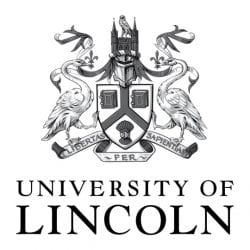
The work of two student conservators from the University of Lincoln will soon be in public view after they were selected to take part in an exclusive scheme to preserve pieces by some of the UK’s leading textile artists, housed on the Parliamentary Estate.
Kathryn Stamper and Abigail Tyler, both postgraduate students on the MA Conservation of Historic Objects programme at the University of Lincoln’s School of Art and Design, have been working throughout the summer on the Emerging Conservators Training Scheme, launched earlier this year by the Parliamentary Curator’s Office.
The scheme provides students with a unique opportunity to work with the Parliamentary Art Collection, one of the UK’s largest public collections of contemporary textiles, while developing practical skills under the guidance of experienced textile conservators.
The results of their work will be unveiled to the public from 21st September 2013 as part of Open House London, an annual event that opens the doors to some of the capital’s most significant buildings and invites people to understand, explore and appreciate architecture in London.
Alongside two other students from the University of Glasgow, Kathryn and Abigail have helped to conserve the renowned Portcullis House Contemporary Textile Collection, which forms part of the Parliamentary Art Collection and is one of the largest collections of contemporary textiles in public ownership.
The works of leading UK textile artists Kate Blee, Allegra Hicks and Jennie Moncur are included in the collection after they were selected as part of the original building design for Portcullis House, which opened in 2001. The building’s architect, Sir Michael Hopkins, selected textiles for their decorative and practical use as they soften the acoustics in Select Committee meeting rooms.
Also in the Collection are two important sets of tapestries from the West Dean Tapestry Studio, which were commissioned by the House of Commons. All the textiles have been in situ since the building opened, and after more than ten years they are now in need of care to ensure they survive in good condition for future generations to enjoy.
Dr Lynda Skipper, Programme Leader for MA Conservation of Historic Objects at the University of Lincoln, said: “The chance for our students to work on live projects such as this provides an excellent opportunity for them to learn new skills and really enhance their understanding of working on site.”
Kathryn Stamper said: “The scheme offered a great opportunity to improve my knowledge of the techniques used for conserving. The experience has improved my practical ability and built up my confidence when working with large and really challenging materials.”
Throughout the scheme, the conservators receive training in surface cleaning, minor repairs, attachment of linings, improvement of existing mounting and hanging systems, and re-installation. They also learned about the history of the Parliamentary Art Collection and the commissioning of its textiles.
For more information on the scheme and to find out more about viewing the collections, visit (www.parliament.uk/visiting/visiting-and-tours/ukvisitors/open-house).










